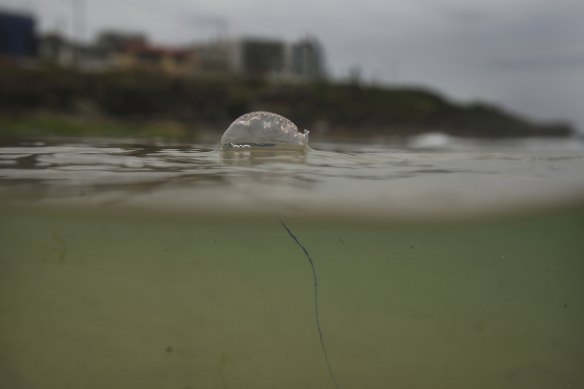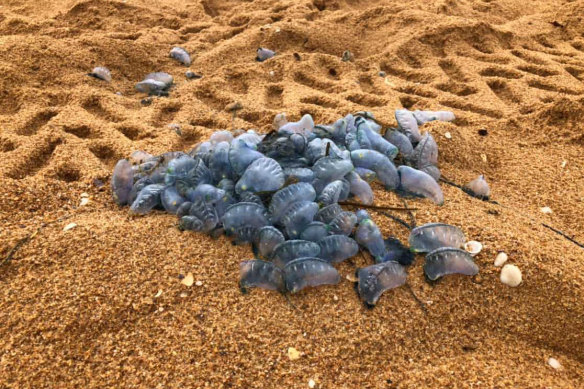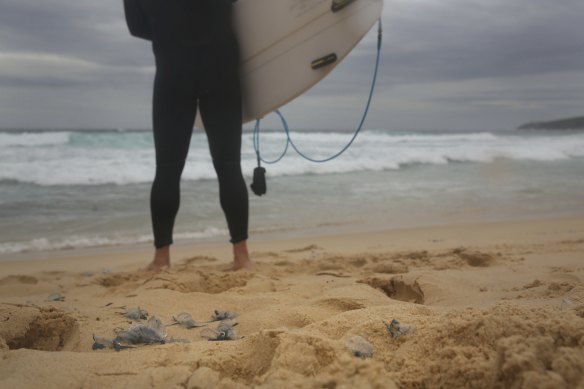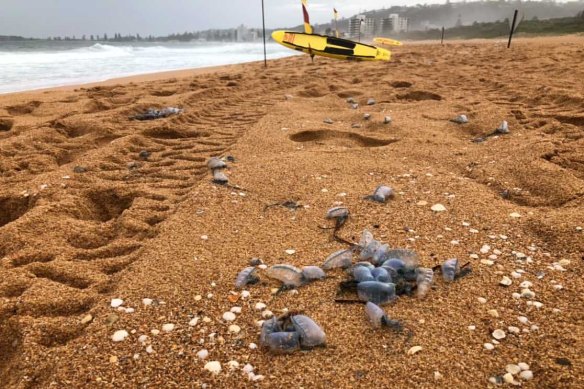By Julie Power
NSW beaches have been invaded by a “bloom” of bluebottles swept onshore by a north-easterly wind that continued throughout Friday night, causing large numbers of beachgoers to be stung.
But for all the people complaining, the sight of their pearly sacs and their tentacles has some raving about their beauty.
Bluebottles, a type of jellyfish, have been spotted on the beaches up and down the coast, including Sydney’s Narrabeen, Manly, Bondi and Maroubra beaches. They have also been blown onto other beaches in NSW, including Terrigal on the central coast, and Gerroa to the south.

A bluebottle just off the sand at Maroubra on Saturday.Credit: James Alcock
According to Surf Life Saving Australia’s Sydney branch director of life saving Matt Spooner, there was a large influx on Sydney’s beaches.
“There’s an abnormally large number but with the weather, the way it is, people have been staying away from the beaches,” said Mr Spooner.

Hundreds of bluebottles have washed up on Narrabeen Beach.Credit: William McInnes
“Large numbers [of people] are being stung,” he said. “The challenge with bluebottles is that so many [stings] are unreported,” said Mr Spooner.
A westerly wind is expected to blow them away overnight in time for tomorrow’s Cole Classic swim.
Marine biologist Dr Penny Berents from the Australian Museum Research Institute usually swims at Manly, but for the last few days she has been avoiding the stingers by swimming in the harbour.
She said these large blooms - the scientific term for large numbers of bluebottles- usually occur every summer when the prevailing wind is a north-easter and when conditions were right for them to reproduce.
“Somewhere out in the ocean, there was the right [mix of] temperature and nutrients, and they produce large numbers quickly and the wind blows them onshore,” said Dr Berents.
Professor Emma Johnston, the dean of science at the University of NSW, said she was stung recently on her lips and arm by a stray tentacle.

Professor Emma Johnston was recently stung by bluebottles. Credit: ABC
Despite the sting, she posted a photo on social media of the beached beauties which are known as siphonophores. These are animals like coral that live as a community near the surface of the water. It is thought that the blue of the gas chamber acts as camouflage or sunscreen.
Dr Johnston, a professor of Marine Ecology and ecotoxicology, said they are “absolutely beautiful” and fascinating creatures, particularly if you encounter them on the beach rather than in the water. The stingers will keep stinging even as a dry specimen in the laboratory.

A surfer stands among stranded bluebottles at Maroubra.Credit: James Alcock
“They are absolutely pearly, you get blue-greens, blues, hot pinks and purple, ” she said. “The light shines through the gas chamber. The tentacles are beautiful as well,” she said.
Compared to stingers in the northern hemisphere, Sydney’s were relatively mild, she said. Nobody has died from an Australian bluebottle sting.
Dr Berents said that bluebottles are able to reproduce quickly and in large numbers, which was typical of animals that produce externally because the larvae suffered high mortality.
“You’ve got to have large numbers to survive on the beaches,” said Dr Berents.
They can also produce sexually or by cloning themselves.
The common bluebottle found in Australia is the Physalia utriculus.

Bluebottles have invaded the NSW coast. Credit: William McInnes
Its blue, balloon like sail sits above the water and is attached to a long tentacle extending below it, says Surf Life Saving.
This tentacle is covered in stinging cells called nematocysts. When this touches the skin it reacts by injecting a small amount of a toxin which causes irritation and can be quite painful. Sometimes it can get caught in someone’s mouth or hair, and wrap around a leg or arm.
What should you do if you are stung?
Here’s is what Surf Life Saving Australia’s Beach Safe App - which also provides information on hazards at each beach including stingers - says:
- Wash off any remaining tentacles with seawater, or pick off with your fingers (they can’t usually sting through the tough skin on your fingers!)
- Immerse the patient’s sting in hot water (no hotter than can be easily tolerated)
- If local pain is not relieved or immersion facilities are not available, the application of cold packs or wrapped ice is also effective.
What shouldn’t you do?
Surf Life Saving says lifeguards are “often amused and entertained by the many strange and bizarre treatments people try to relieve the pain of these stingers.”
For example, urinating over the sting was “just gross, and doesn’t work anyway,” it said. Pouring soft drink over a sting just makes it itchy.